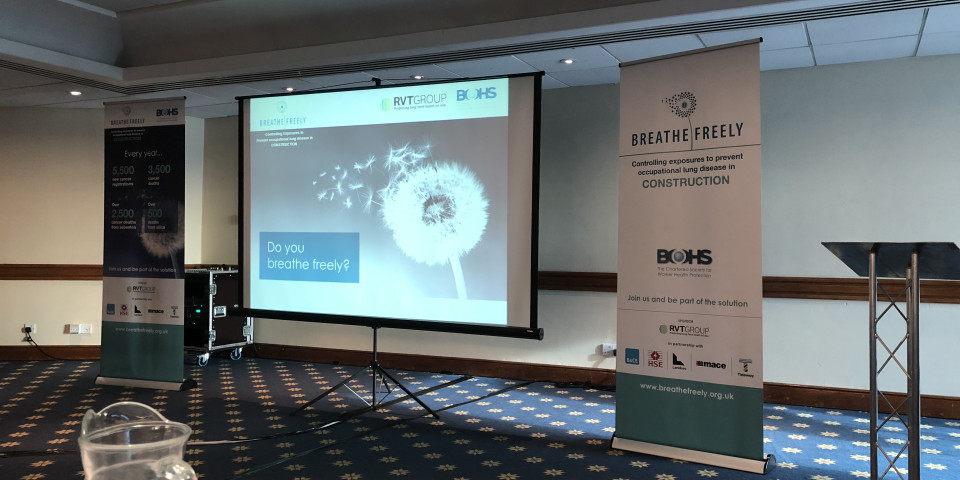Latest News
HSE #Dustbuster Update and Breathe Freely Seminar
Posted on Friday, 7th December 2018

This week one of our team went along to a Breathe Freely seminar that was a part of their Breathe Freely in Construction campaign. Darren O'Neill, our Training & Consultancy Director, updated us all on what he saw at the seminar, plus jotted down some key findings from the Dustbuster campaign that was launched earlier this year by the Health & Safety Executive.
Breathe Freely Seminar
Hi, Darren here. Earlier this week I attended a Breathe Freely event. The ‘Preventing Lung Disease in Construction’ seminar is part of a series of roadshows taking place across the UK in 2018. The workshops are organised and led by the Breathe Freely, as part of their campaign targeting the construction industry and the RVT Group.
Breathe Freely is a BOHS initiative, aimed at reducing occupational lung disease in the UK, which causes significant debilitating ill-health and an estimated 13,000 deaths per year. Here at Essential Site Skills we strongly support what Breathe freely do, as they not only raise awareness about respiratory illnesses but also inform the industry what they can do to help prevent illnesses and protect their workforce.  This is exactly what the aim of the seminar was that I attended.
This is exactly what the aim of the seminar was that I attended.
Attended by many who look after the health of construction workers, we had the opportunity to listen to some industry case studies and learn good practice examples when it comes to respiratory health. There was also several resources and tools made available to health and safety professionals.
For me, one of the most interesting parts of the day was the update provided on the HSE Dustbuster campaign.
Dustbuster Update
The HSE Dustbuster campaign was launched earlier this year to great applause and industry support, we blogged about it at the time and shared some team photos but there was also concern from businesses as part of the scheme included site inspections.
Now, HSE has published some of their findings, including statistics and recommendations.
During the Dustbuster campaign, HSE issued 142 notices and 42 prohibition notices to firms that were found to not adequately be protecting employees from the hazards of dust or putting enough control measures in place.
The main findings of the campaign were:
- Contractors are starting to look more at removing risk but some not aware of the wide availability of controls available to them
- Often, those contractors that did have control measures in place they were let down by application i.e. the user not using it or not knowing how to
- A big reliance on RPE/PPE
- Dry sweeping still an issue
- LEV or on tool that has been used, often, the wrong type
It was great to hear that the construction industry is now moving more towards designing risks out of the equation, therefore eliminating the hazard. The holy grail example being the Saw Swee Hock Centre in London, where during construction 175,000 bricks were molded, shaped and cut before arriving on site, almost eliminating the dust risk on site.
Top of HSE’s three main priorities is lung diseases and as ever, we are firmly behind both HSE and Breathe Freely when it comes to advocating the correct training, equipment and risk management when it comes to respiratory health.
In fact, HSE recommends one of the courses we provide, Certificate in Controlling Health Risks Construction (CCHRC) for all contractors to put their site supervisors or managers through. The one-day course provides learners with the knowledge to identify and control common health risks on construction sites in order to prevent illnesses, including respiratory diseases.
There are several other courses that we strongly recommended for those who work with dusts, or health and safety professionals who manage sites and areas contaminated by dust. Face Fit Testing being one of the most important.
We also offer one of our own in-house courses; Dust Management - Construction. Our Dust Management course for the Construction Industry is for anyone who has functional responsibility for controlling dust risks on a construction site, such as site Supervisors, Managers and Directors. It provides learners with the knowledge to identify and control common dust hazards in order to prevent workplace ill health and prevent unwanted HSE sanctions.
Please get in touch if you are interested in any of these courses or want to know more about controlling dust risks on site.
Darren O'Neill.


